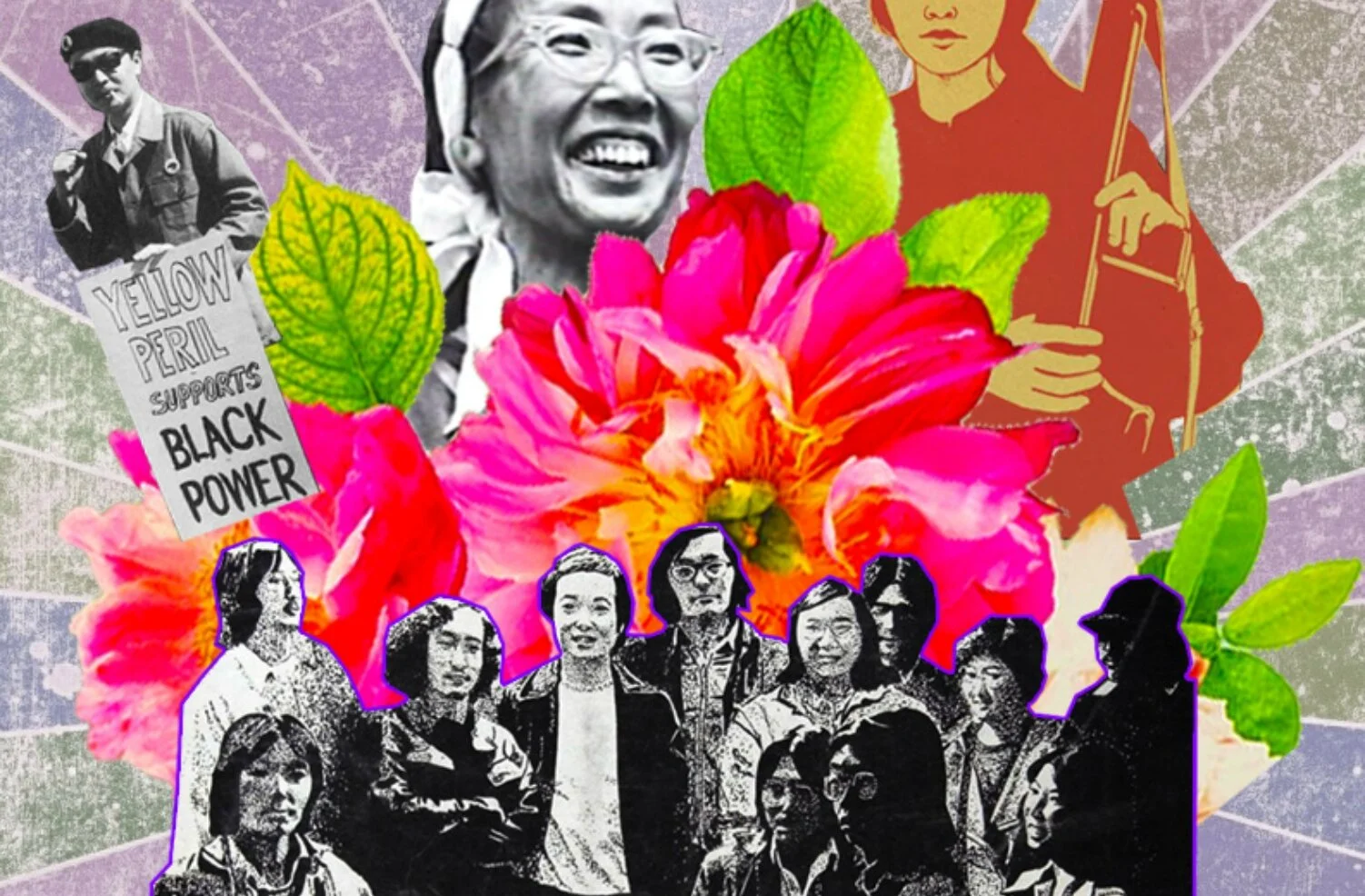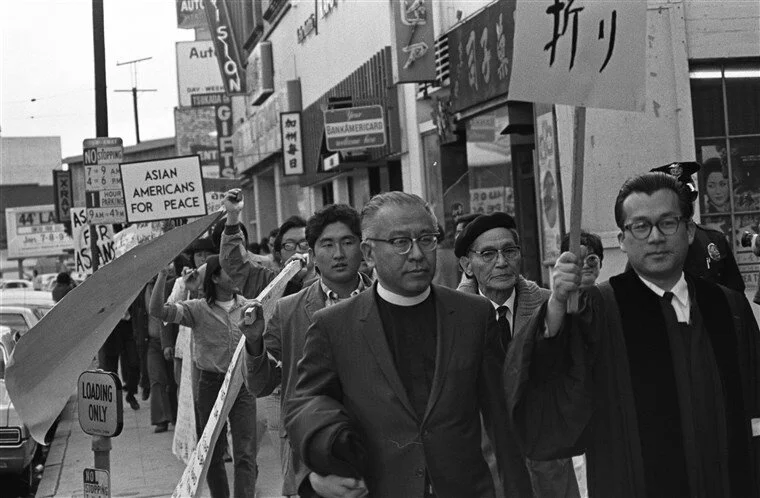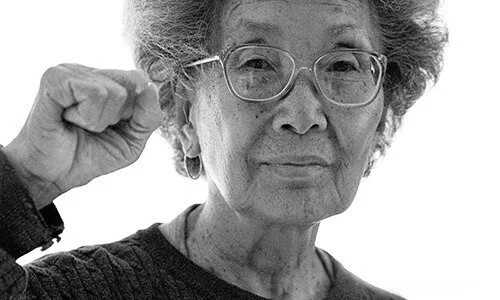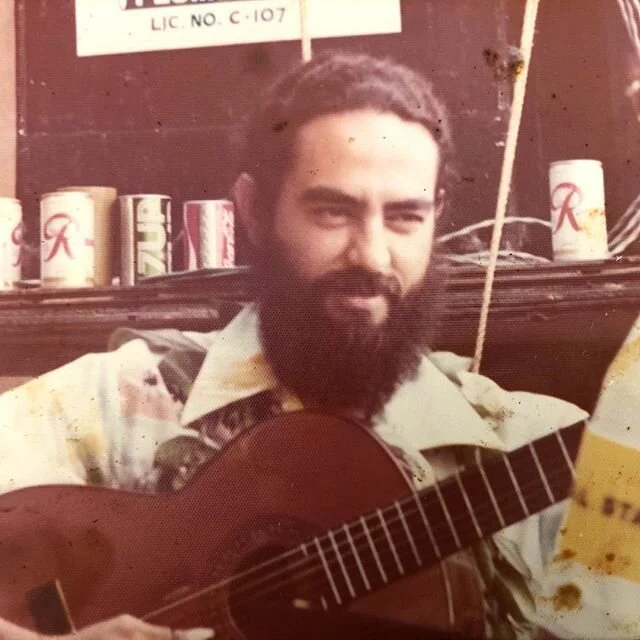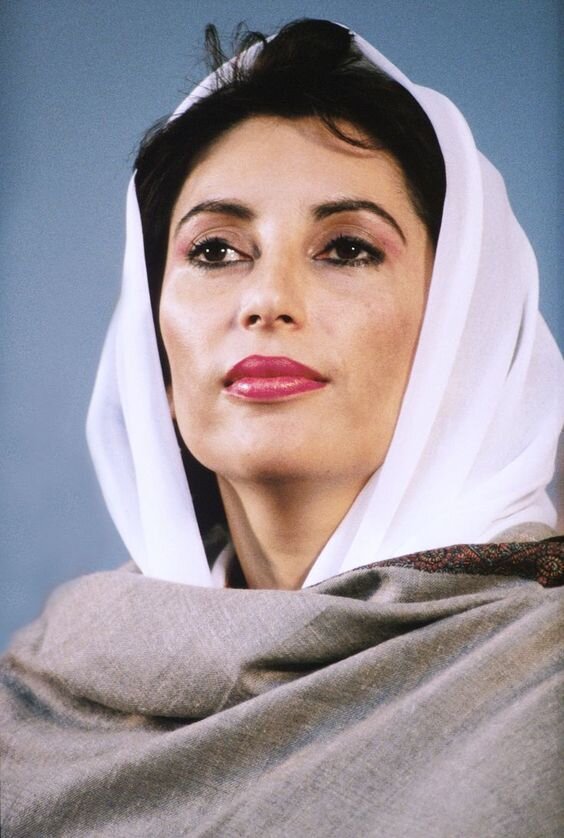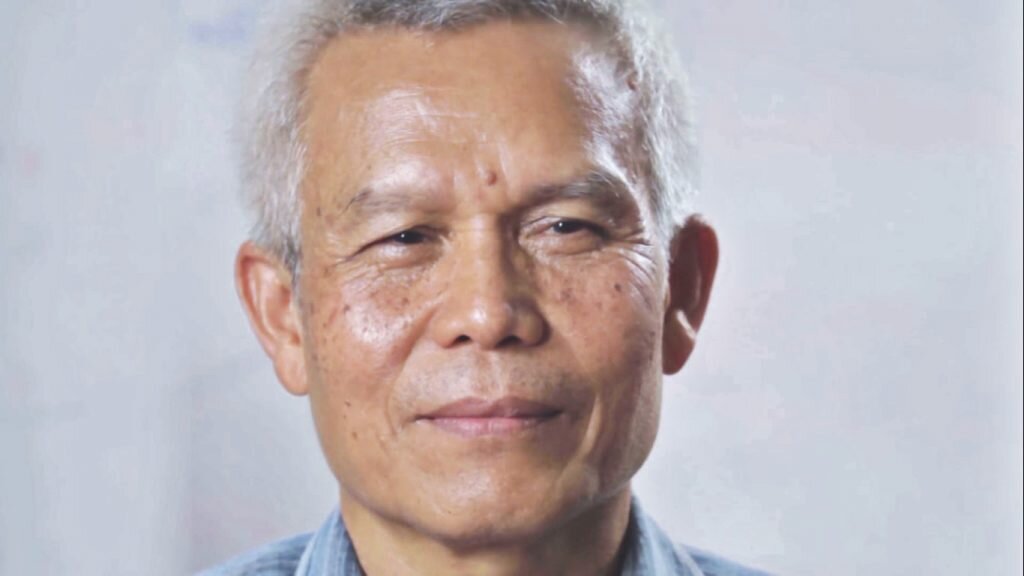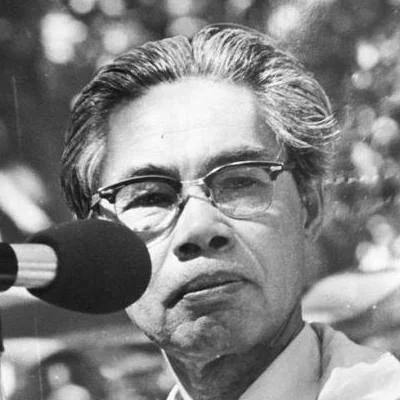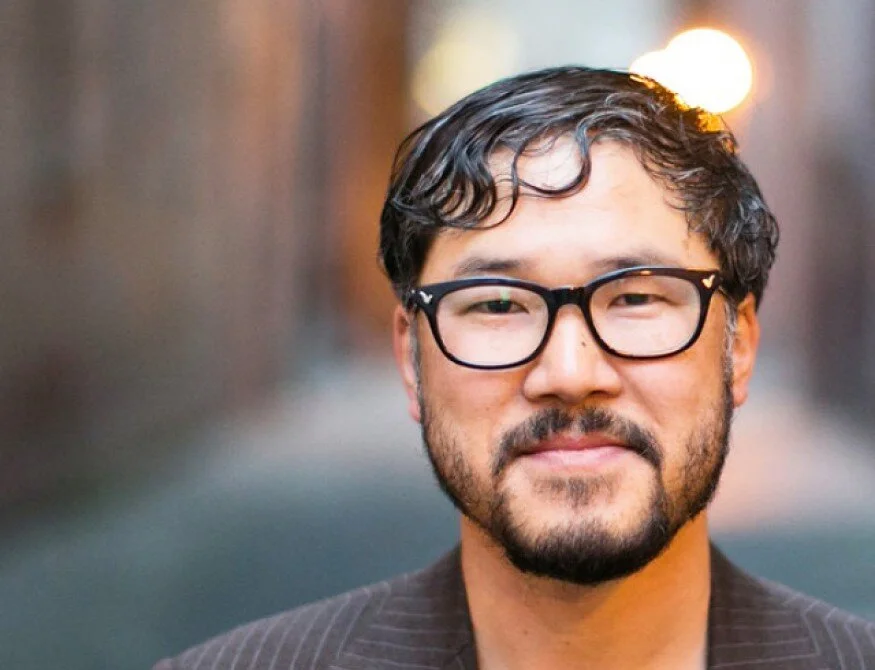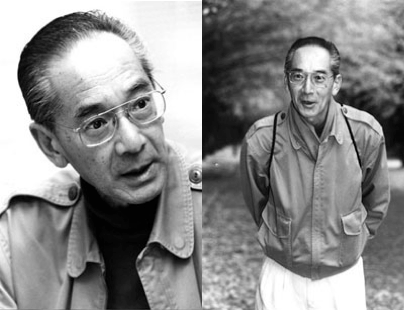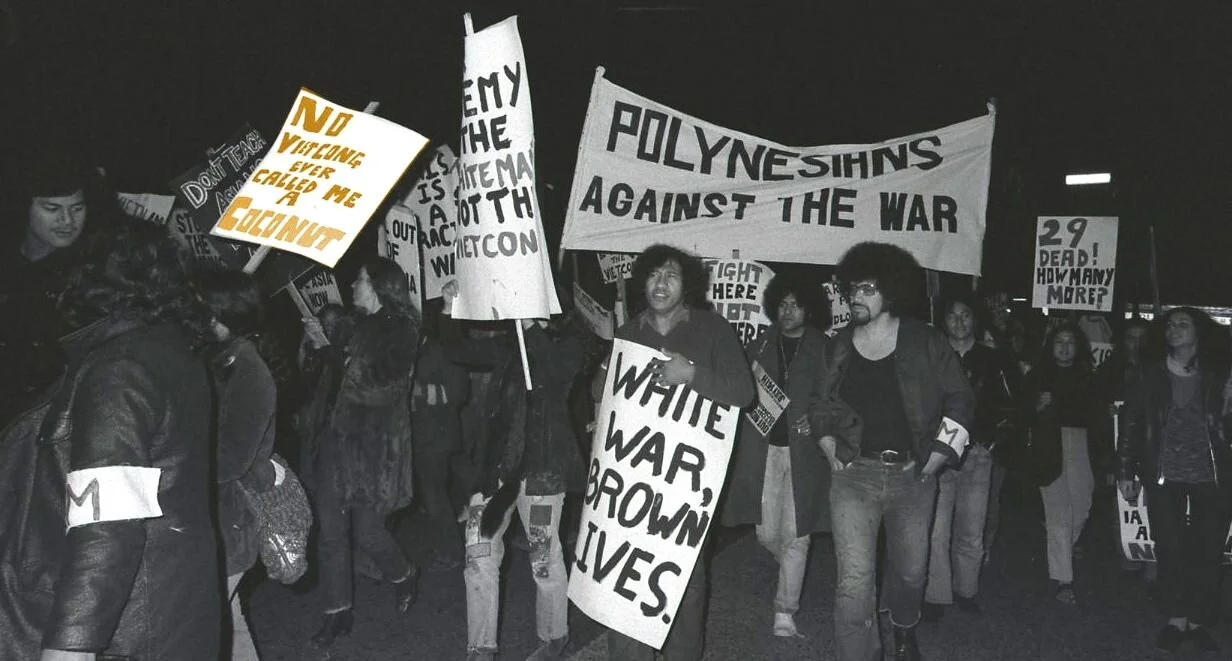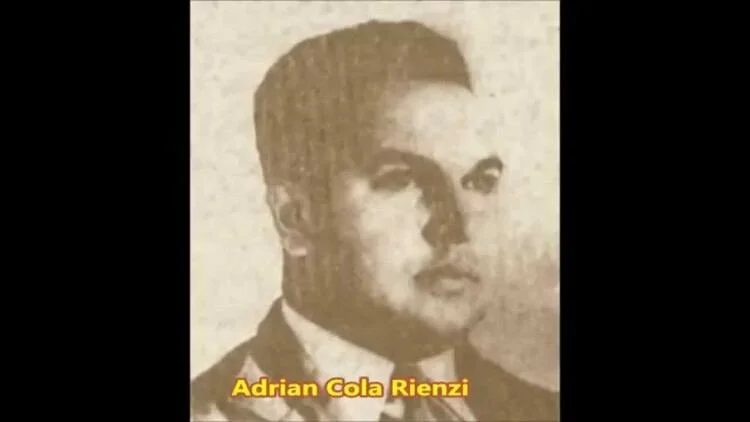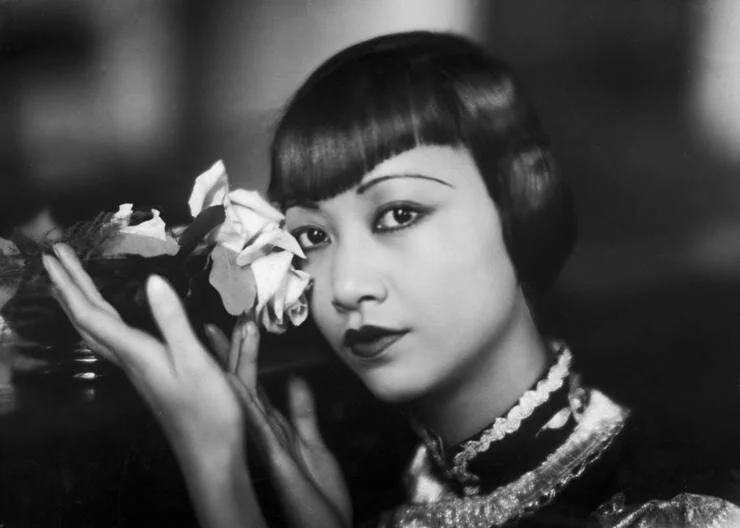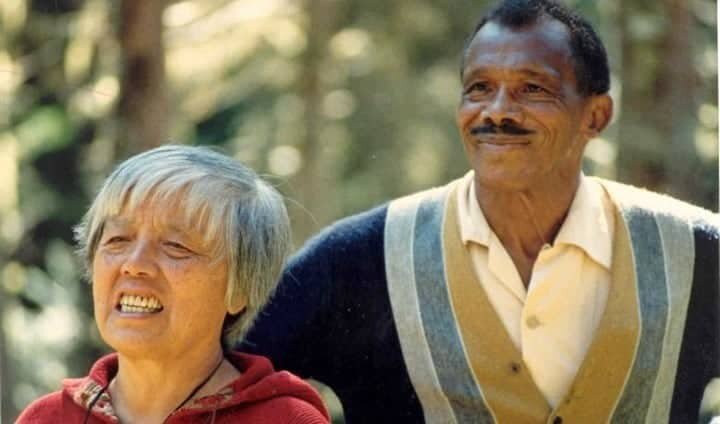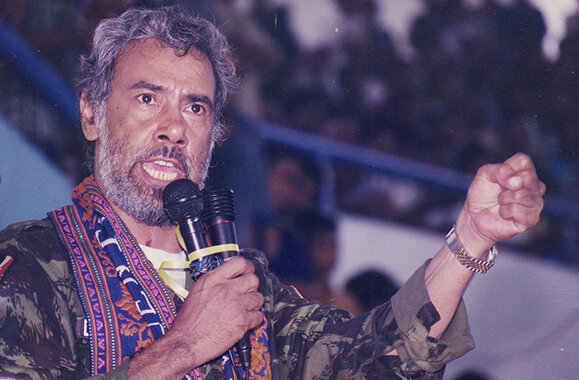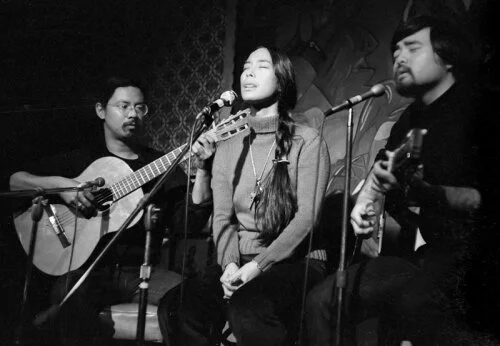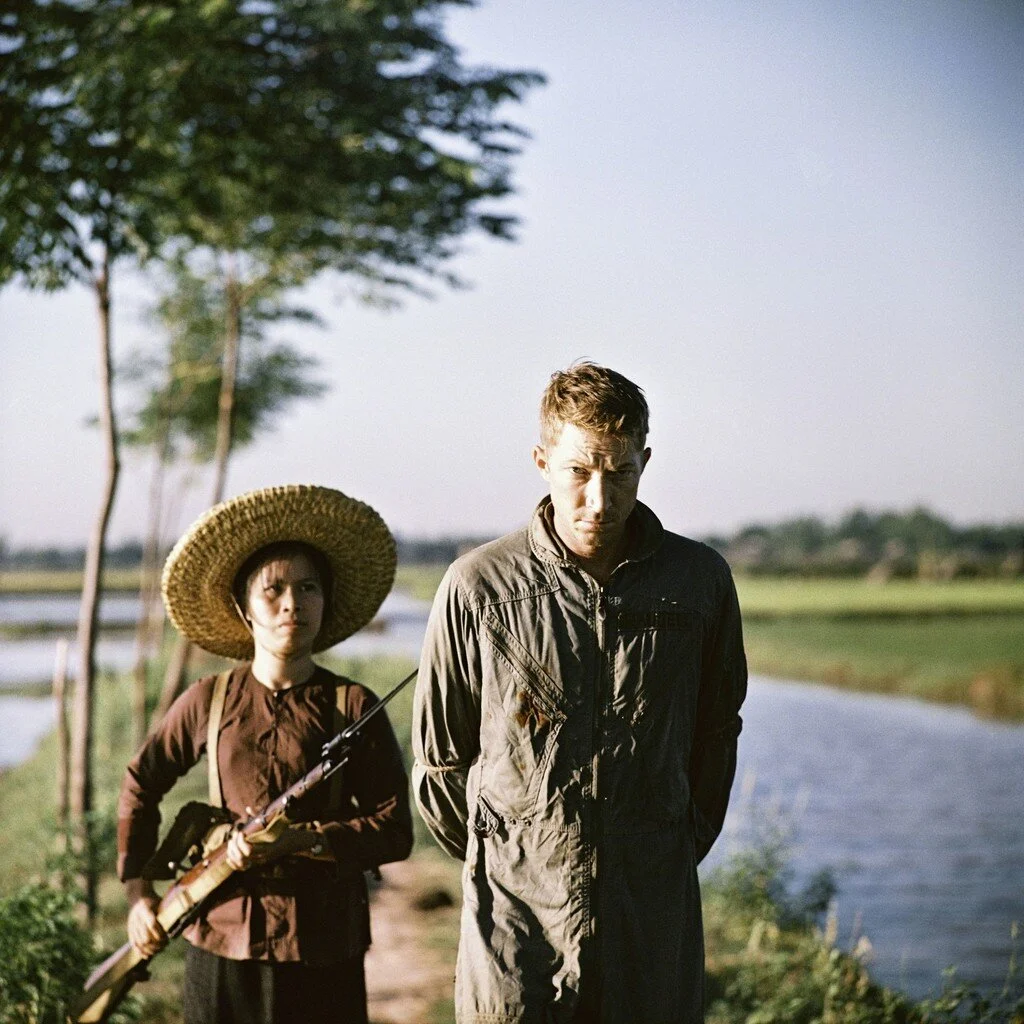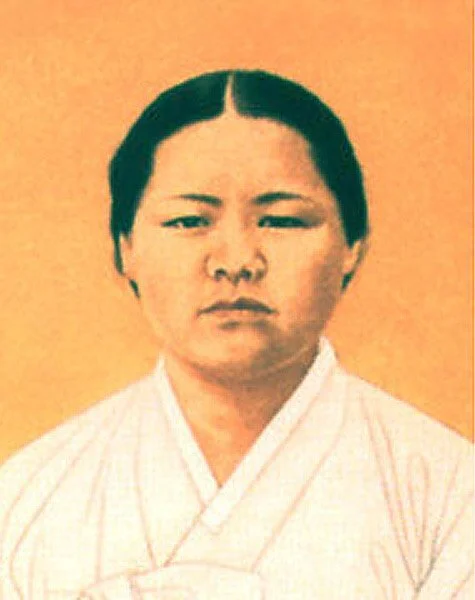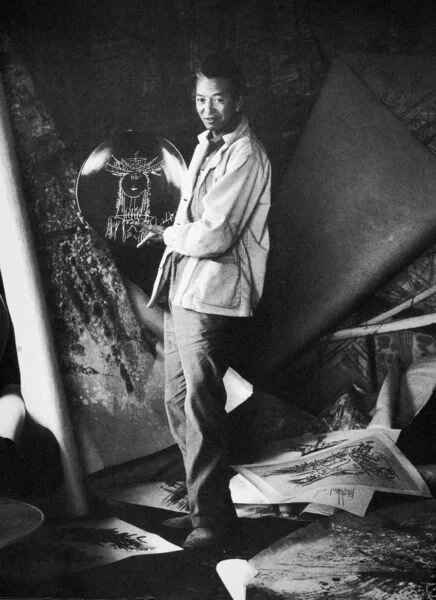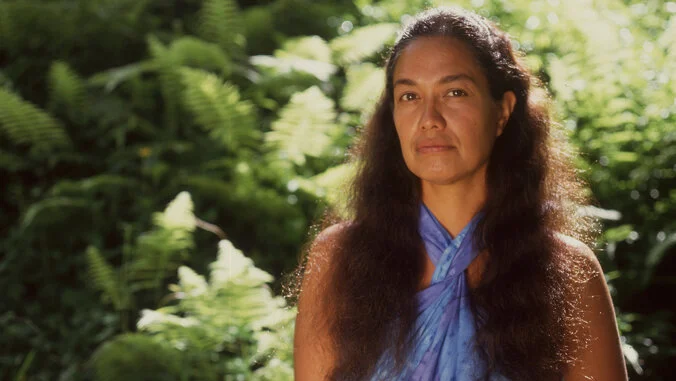AAPI Heritage Month
Artwork/art collage done by Heidi Kang for revival issue of Gidra zine, Photo Courtesy by Los Angeles Magazine.
May is Asian American and Pacific Islander (AAPI) Heritage Month in the United States. AAPI heritage month is a celebration of the accomplishments of Asian Americans and Pacific Islanders in U.S. society and culture; most often these lists are made up of AAPI doctors, scientists and those holding positions within the U.S. government. Rarely shared are the stories of those within the AAPI community who have stood up against racism and injustice which shaped a much fairer society, and those who have used the arts as a medium of change. The United States has a long history of extreme racists policies against its Asian and Pacific Islander citizens, and throughout the history of this country, these communities have fought back.
The Chinese in the United States faced great hardships upon their arrival; in 1871, there was a massacre of Chinese immigrants in Los Angeles, California. The Chinese Exclusion Act further legalized anti-Chinese sentiments. Chinese radicals fought against the abuses they faced and did not stay silent. Chinese women in the garment industry made history through strikes and uprisings in the 1980s, and Su Ko Lee led a strike in the 1930s fighting for higher wages.
U.S. citizens of Japanese descent were rounded up and sent to incarceration camps during WWII; Canada followed suit and sent their Japanese citizens to similar camps. Durning this time, the governments of Perú, Chile, Argentina and México sent many of their citizens of Japanese origin to the United States to be detained.
The U.S. genocide and enslavement of Filipinos during war and colonization is still virtually unknown to many, as is the fact that Filipino labor workers first began organizing and striking in agricultural fields, pioneering the farm labor movement in the United States.
The U.S. government brutalized South East Asia during the Vietnam War; over 2 million tons of cluster bombs where dropped in Laos, simply because if its geographic location to Vietnam, making it the most bombed country in the history of humanity—creating a legacy of death, trauma and amputations. The U.S. government also recruited Hmong child soldiers to fight the Vietcong and caused a major refugee crisis in the region.
U.S. aggressions against Polynesia and oceania
Take a deep breath and repeat after me, “Hawaiʻi is NOT the United States and it is a stolen kingdom.” Now exhale. Not only did the United States, and its sugar and fruit companies, steal the kingdom of Hawaiʻi from its people, Hawaiian land has been used for bomb testings, destroying precious ecosystems and its indigenous peoples have been displaced and disenfranchised. Native Hawaiians are often seen as merely “exotic” tourist attractions in their own land.
American Samoa, Guam and the Northern Mariana Islands are all colonies of the United States government whose economies are strangled. Most citizens live in poverty yet have sent hundreds of thousands of men and women to battle for the U.S. military. They have no true rights nor sovereignty over their own affairs and land.
Asia is a large continent
Asia is a very large continent that encompasses countries within East Asia, Eurasia, West Asia, Central Asia, South Asia and South East Asia. Asia is made up of many different ethnic groups, peoples and cultures who practice many different faiths. Even within respective Asian countries there are varying people groups, customs, languages and traditions—not all Asians are “the same”.
the global asian struggle continues
To this day, there are still Asian struggles across the globe; Filipina women face grave abuses and exploitation working as nannies and domestic workers in the Arab Gulf States and Hong Kong. Many have their passports taken from them upon arrival, are subjected to verbal, sexual and physical abuses and can rarely escape. Bangladeshi women and children have been killed working in sweatshops that have collapsed while sewing the cheap clothes that we consume; they are also paid very little and work in slave-like conditions. Asians and Pacific Islanders across the globe are fighting against gentrification, racism, sexism, classism, police brutality and capitalism. And anti-Asian sentiments across the globe are becoming normalized due to the Covid-19 outbreak, furthering discrimination.
Asians and Pacific Islanders in activism
Many believe that Asian communities have remained silent in the midst of social injustices, however, Asians and Pacific Islanders have a long history of intersectional activism. Throughout history, API communities have joined global liberation and independence struggles. Asian and Pacific Islanders have made revolutionary impacts in many arenas, and this blog post is dedicated to honoring their efforts in the global liberation struggle.
30 revolutionary Asians and Pacific Islanders from around the world to celebrate for AAPI Heritage Month:
1. yuri kochiyama
Yuri Kochiyama was a radical Japanese-American liberation activist and a pioneer of the intersectionality movement. Born in California to Japanese immigrants in 1921, Yuri lived what she felt was an “all American childhood”. After the Japanese attack on Pearl Harbor her life would drastically change; Yuri’s father was arrested by the FBI, accused of being a “threat to national security”, was detained for six weeks and died just days after his release. Yuri, her mother and brother were some of the many U.S. citizens of Japanese descent to be held in incarceration camps; it was in the camps where Yuri developed a deep pride in her Japanese heritage and the experience sparked her passion for activism. She married Bill Kochiyama and they had six children; Yuri and Bill moved to New York City with their children and lived in housing projects surrounded by Black and Latino communities. Yuri advocated for safer streets and integrated schools, this led her to dig deep into the histories of Black Americans and Puerto Ricans. Yuri’s daughter remembers piles of radical leaflets all over the dinner table and her mother taping political newspaper clippings to the walls of their home—she said that their home “felt like ‘the movement’ 24/7.” Yuri and Bill would take their children on summer vacations to the Southern United States to see landmarks of the civil rights movement that was taking place. Fate would lead Yuri to a close friendship with Malcolm X, with whom she shared a birthday, that would radically change the course of her life. Yuri had been an advocate for integration, but her friendship with Malcolm was eye-opening; Yuri changed the course of her activism and began to fight for the total liberation of marginalized peoples around the world. Yuri understood that the fight against oppression and capitalism was global and in order to win the fight, marginalized peoples must unite. Yuri joined the Republic of New Afrika, a militant Black nationalist organization based in Harlem. She also joined the Young Lords Party, made up of radical Puerto Ricans in the NYC diaspora, and her work in the Asian struggle movement was extensive. Yuri was opposed to the Vietnam War, supported labor organizing, helped develop ethnic study programs and fought for compensation for Japanese concentration camp survivors. Yuri was present at some of the most iconic moments of the liberation struggle; she was at the Audubon Ballroom listening to Malcolm X speak when he was murdered—Yuri famously rushed to the stage and held his head as he lay dying crying out, “please, Malcolm! Please, Malcolm! Stay alive!” In 1977, the Young Lords famously occupied the Statue of Liberty and laid the Puerto Rican flag across it—Yuri was there. After the 9/11 attacks in New York City, she organized against the racial profiling of Arab Americans, Muslims and the South Asian community. Yuri is one of the founding members of Asians for Mumia, in solidarity with imprisoned former Black Panther, Mumia Abu-Jamal—Yuri was known to sign her Christmas cards with “free Mumia”. Yuri unapologetically supported radical, anti-imperial groups around the world who challenged injustice. She is an example of true solidarity amongst marginalized peoples, and her intersectional activism should be mirrored by all.
“Fight against racism and polarization, learn from each other’s struggles...ethnic groups need their own space but there are enough issues that we could all work on [together]. ”
2. GEORGE HELM JR
George Helm Jr was a Native Hawaiian musician, singer, activist and Native Hawaiian cultural expert. Helm was also a philosopher and considered the pioneer of modern Hawaiian sovereignty ideals, and he prided himself on living in the traditional ways of his ancestors. Helm was on the frontlines of activism, and in 1975, he became heavily involved in the efforts to protect the island of Kaho’olawe from U.S. naval target practice bombings. In 1976, he, along with eight other activists, occupied the island in protest in of its military occupation; Helm became connected to the spiritual power that the island possessed and dedicated his life to protecting it. Helm disappeared in a boat in 1977 off the coast of Kaho’olawe, but his passion for Hawaiʻi’s sovereignty and protection of the land has inspired generations of Kanaka Maoli.
3. Benazir Bhutto
Born in 1953, Benazir Bhutto was a Pakistani politician. She served two terms as prime minister starting in 1988. She was the first woman to lead a Muslim-majority nation, and she co-led the Pakistan Peoples Party (PPP), a left-wing, socialist organization for nearly thirty years. Her father served as Pakistan’s foreign minister, which is equivalent to the Secretary of State in the U.S., and she grew up around foreign figures such as Henry Kissinger who often visited her father. Her father would eventually become the first democratically elected leader in Pakistan and gave Benazir the opportunity to accompany him all over the world, meeting heads of state. After her father’s execution in 1979, Benazir took over as head of the PPP and was placed under house arrest by the military dictatorship for five years. She spent two years in exile in London and returned to the country in 1988 to run for Prime Minister—which she won. After government changes and challenges, Benazir left Pakistan with her children and lived in Dubai for eight years. In 2007, she returned to run for prime minister and was killed by gunfire and a suicide bombing while campaigning. During her two terms as prime minister, she worked to improve relations between Pakistan and India, she appointed women judges, established a women’s bank and all-female police force.
4. Sombath Somphone
Sombath Somphone is a Lao community development worker and activist who has been missing since 2012. Born in Lao in 1952, Somphone would spend his high school years in the United States and attend university in the Kingdom of Hawaiʻi. Born into a large, poor farming family, Somphone was dedicated to sustainable farming practices that would benefit the Lao people; he received a bachelor’s degree in education and a master’s in agriculture. After his return to Lao, he was granted permission by the Education Ministry to train youth in community development; he helped to reintroduce organic fertilizers into the country and educate the public on eco-friendly practices such as recycling. Somphone began to speak out against lucrative land sales that had been approved by the government but left rural citizens homeless. The sale of land sparked outrage across the country that led to unprecedented acts of resistance within Lao as people began to protests. On December 15, 2012, police stopped Somphone in his car in the Lao capital of Vientiane; he has not been seen nor heard from since.
5. Tilsa Tsuchiya
Tilsa Tsuchiya was a Japanese-Peruvian-Chinese artist famous for her paintings and prints based on Peruvian mythological legends and folklore. Her father was a doctor who immigrated to Perú from Japan, and her mother was of Peruvian and Chinese ancestry. She was drawn to artistic expressions at an early age and began her career as an artist by drawing pictures; she would eventually study at the Escuela Nacional Superior Autónoma de Bellas Artes (National Superior Autonomous School of Fine Arts) in Lima. Her father passed away in the middle of her studies, and her mother just two years later. After the death of her mother, she left school and opened a framing shop with her brother. She would return to school a few years later, studying under prestigious Peruvian artists such as Carlos Quizpez Asín and Manuel Zapata Orihuela. Tsuchiya stood out amongst her classmates due to her creativity. She won a gold medal for painting while in university and graduated with honors. She would continue her studies in France where she expanded her expertise from painting to engraving and printmaking. While her work was deeply influenced by Peruvian mythological legends, she also used her art to push gender narratives and expressions of female sexuality. She is hailed as one of the most influential and celebrated Peruvian artists.
6. Philip Vera Cruz
Philip Vera Cruz was a Filipino leader in the Asian American Movement, a farmworker and a leader in the labor movement. He also organized alongside César Chávez and fellow Filipino labor leader, Larry Itliong. Born in the Philippines in 1904, Vera Cruz moved to the United States in 1926 where he eventually became a farmworker. Farm work in the U.S. at the time was nearly slave labor, and most jobs were held by Filipino workers. Laborers worked ten-hour days for seventy cents per hour in grueling 110-degree heat. They lived on filthy labor camps with outdoor showers, kitchens that were infested with roaches and mosquitoes and toilets so filled with feces that they were nearly impossible to use. Laborers had very little rights on the job, no access to benefits nor healthcare provided to them. Vera Cruz picked grapes, lettuce and harvested asparagus. He joined his first strike in 1948, organized by Filipino farmworkers who worked in asparagus fields. This strike would inspire Filipino laborers across California, and it was one of the acts that sparked the entire farm labor movement in the United States. Filipino workers began to organize all over the state and Vera Cruz would lead chapters in his local unions. While most people associate the Delano Grape Strikes with Mexican Americans and César Chávez, they were started by Filipino-American workers, of which Vera Cruz was one of the early organizers. Filipino workers decided to merge their unions with those of Mexican Americans, creating the now-famous United Farm Workers (UWF). Vera Cruz would serve as the second vice president of the union, and he also served on the managing board. Vera Cruz stayed radical his entire life, fighting for workers’ rights and inspiring college students to fight for the underrepresented.
“My life within the union, my life now outside the union, are all one: my continual struggle to improve my life and the lives of my fellow workers. But our struggle never stops.”
7. junko Tabei
Junko Tabei was a Japanese mountaineer and the first woman to reach the top of Mt. Everest. She was also the first woman to climb the highest peak on every continent. She founded the Joshi-Tohan Club, which was a women-only mountaineering club in Japan—the first of its kind. She wanted to create a space for women in Japan to discover climbing, and as a way to combat the discrimination she had encountered in all-male climbing groups. Tabei refused to take corporate sponsors and funded all her own trips. She funded her climbs through tutoring children in English, accepting paid public appearances and leading mountain climbing tours. She was also an avid environmentalist whose postgraduate studies focused on the degradation of Mt. Everest due to the waste left behind from climbing tourism. Tabei revolutionized the ideals of who a Japanese woman, wife and mother could be. By the end of her life in 2016, she had scaled 70 mountains, many of which were some of the highest in the world.
8. Eugene cho
Eugene Cho is a Korean-American pastor, human rights advocate and author. Born in South Korea and raised in San Francisco, California, Cho is a radical voice within the world of evangelicalism. He is the founder and former pastor of Quest Church, a multiethnic congregation in the Seattle, Washington area. The church shifted from an Asian-focused ministry to become a body of multicultural worshipers who call out injustice, live in humility and who live out the true, radical teaching of Jesus. Cho has consistently stood in solidarity with Indigenous peoples, Latinos and Black Americans; he stands in support of Palestine and its people, while also advocating for issues within the Asian community. Cho also speaks out against global poverty and environmental injustices.
9. Queen Velu Nachiyar
Velu Nachiyar was a Tamil queen from India who fought against the invading British and their colonial power. Known as the “brave woman”, she was born in 1730 as a princess into the Ramnad kingdom. She was the only child of her parents and was raised as if she was a male heir who would one day rule the kingdom. Queen Velu was trained in martial arts, horse riding, war weapons and archery. She became a scholar of foreign languages and spoke fluent Urdu, English and French, along with her native Tamil. She married the king of Sivagangai, with whom she had a daughter, and they ruled the kingdom for more than twenty years. Their kingdom was eventually attacked by the British and her husband killed—Queen Velu and her daughter fled for their lives. After the king’s death, Velu took to battle to avenge his murder and to fight back against the colonial oppressors. She formed an army and built alliances with other kingdoms within India to attack the British. One of her closest allies was the sultan of Moysore, whom she impressed by her fluency in Urdu. This friendship led her to more allies who helped her build a powerful army to attack the British. The sultan provided her with a 400 pound salary per month, she was revered as a queen while in exile and was given 5000 calvary and 5000 infantry soldiers to help in her quest of destroying the British, along with plenty of weapons for the battle. In 1780, Velu learned the location of a British weapons storehouse; she arraigned a suicide attack against the storehouse to destroy the weapons. A woman named Kuyili, who was a commander in the army and adoptive daughter of Velu, doused her body in ghee, set herself on fire and then jumped in the armory, blowing it up. This was a devastating blow to the British and a huge victory for Queen Velu. The queen’s second adoptive daughter, Udaiyaal, also destroyed a British arsenal in a separate suicide attack—Velu would create a women’s army and named it after Udaiyaal. Queen Velu recaptured Sivaganga and is one of the few royals to regain their kingdoms from the British. She ruled for ten more years and at her death left the throne to her biological daughter, Vellacci.
10. Cecil Rajendra
Cecil Rajendra is a Malaysian poet, human rights activists and lawyer. Commonly referred to as the “lawyer-poet”, he has spent decades providing legal aid for the poor, pushing to make Malaysia’s justice system work for all and writing poetry—his writing is comprised of complex themes such as human rights, environmental concerns and repressive laws. In 1980, Rajendra and friends set up a free legal aid clinic in a little wooden shack in his hometown of Penang. Many workers were confronting sexual harassment, inadequate working conditions, poor housing and even weren’t receiving payments for their labor. Rajendra also spearheaded the movement against Malaysia’s Internal Security Act, which allowed persons to be held without official criminal charges or trials under specific circumstances as defined in Malaysian law. He created the first mobile legal aid clinic in the country, giving citizens the opportunity to learn about their legal rights. In 2019, Rajendra won the International Bar Association’s pro bono award for his groundbreaking work on behalf of Malaysia’s most underrepresented citizens. He is also the author of over 25 books, and his poems have been published in over 50 countries.
11. Yorm Bopha
Yorm Bopha is a Cambodian housing rights and land activist who was jailed for her opposition against a luxury development in her community that led to the ousting of thousands of local residents from their homes. The Boeung Kak Lake is centrally located in the Khmer capital of Phnom Penh, making it prime real estate for foreign developers to expand. When a foreign company was given a 99-year lease to develop in a central, urban area surrounding the lake, Bopha and her neighbors found themselves being pushed out of their homes. Many residents received meager compensation and were left without enough money to buy new homes while others were relocated to areas far from their places of employment and were left without transportation. The development company filled the lake with sand to drain it, causing fish and agriculture to virtually disappear, thus having an economic impact on the local community who relied on these as income sources. Angered by over 3,000 local residents losing their homes, Bopha grabbed a megaphone and organized her community to stand against their government and developers. Bopha fought her way through police barricades, withstood water canons and demanded that residents were compensated fairly. She was eventually arrested and charged with allegedly assaulting two taxi drivers, and served jail time on what many believed were false chargers to squash the resistance she led. After protests and an international outcry, Bopha was released and continues to fight against gentrification.
12. Yuji Ichioka
Yuji Ichioka was a Japanese American civil rights activist and historian. He was born in San Francisco in 1936 to Japanese immigrant parents. Ichioka and his family were held at the Topaz Japanese incarceration camp in Utah after the U.S. government declared war against its Japanese citizens, deeming them as enemies of the state during WWII. After their release, the family would return to the Bay Area and settle in Berkley. Ichioka attended UCLA for his undergraduate studies and eventually moved to New York City to attend Columbia. Shortly after arriving in New York City, Ichioka decided to abandon his studies to visit Japan for the first time. This trip sparked a profound cultural awakening, inspiring him to learn the language, explore the culture, and reflect on the experiences of Japanese immigrants in the United States. Once he returned to the U.S., Ichioka attended Berkeley University where he earned a master’s degree in Japanese history. He became involved in activism and encouraged younger Asian Americans to join the anti-war and civil rights movements. He also played a significant role in the forming of the Asian American Political Alliance and taught the first-ever Asian American studies class at UCLA. He is credited with coining the term “Asian American”, which was revolutionary at the time as Asians were identified as “Orientals”. Ichioka found a term that would unite Asians in the United States as one, creating a sense of solidarity and pride. He continued his research on Japanese Americans until his death in 2002.
13. the Polynesian Panther party
The Polynesian Panthers were a liberation activist group that fought for Polynesian and Māori empowerment in New Zealand. Inspired by the Black Power movement in the United States, along with Māori protests within the country, inner city youth in Auckland were emboldened to stand against capitalism and to fight for visibility. Auckland’s urban areas were filled with Pacific Islander immigrants, and their Kiwi-born children, who were subjected to police brutality, faced harsh discrimination, disenfranchisement and were constantly called racial slurs—"Black bastards” and “dumb coconuts” were often yelled at young Tongan and Samoan boys. Poverty was rampant, and the lack of opportunities and access to quality education was taking a toll on the new generation of Kiwi-born Pacific Islanders. The undocumented in the community lived in fear of dawn raids where police raided mostly Polynesian homes in the early morning, targeting those who may have overstayed their visas. Founded in 1971 by Fred Schmidt, Nooroa Teavae, Paul Dapp, Vaughan Sanft, Eddie Williams and Will 'Ilolahia, the Polynesian Panthers members were made up of university students, high schoolers and former gang members. They stood against the exploitative nature of capitalism and believed that overthrowing its system was one of the most fundamental paths toward liberation. The group joined the anti-Vietnam War movement, created after school homework help programs in their communities, ran food co-ops and promoted Polynesian languages and visibility in mainstream New Zealand culture; the group also advocated for tenets’ rights and fought against slumlords renting in Polynesian communities. Brown Pacific Islander boys couldn’t ride their bikes in their neighborhoods without being stopped by the police; they were constantly harassed as police demanded to see their IDs and passports. Those who did not carry them were immediately jailed until a passport was produced. In response, the Polynesian Panthers created the Police Investigation Group (PIG) to monitor the location of police officers and the community and their harassment. They also successfully petitioned to get stoplights placed in their neighborhoods as many Polynesian children were being killed while trying to cross the streets. The group worked closely with Māori activists and stood in solidarity with the oppressed peoples around the world. They are also credited with founding the Pacific Resource Centre, and the fruits of their radical labor are still seen throughout the country today.
14. Arlen Siu
Arlen Sui was a Chinese-Nicaraguan revolutionary icon. She was born in 1955 to a Chinese immigrant father and a Nicaraguan mother. She joined the Sandinista movement when she was 18 years old. Sui was a talented singer, songwriter and musician who played multiple instruments—she loved poetry. She authored the poem, Rural María, which tells the story of poor, suffering mothers in rural Nicaragua. The poem has since been turned into a song sang by varying artists in Latin America. Her concerts on the university campus were often under watch of the national guard, who placed snipers around the university to monitor political activity. Siu also authored many feminist writings that have become widely read and admired in the country. She fought for women to have political importance within the Sandinistas and would eventually be killed at 20 years old in an ambush by national guard. She is hailed as a martyr and one of the first women killed in the revolutionary movement.
“Arlen is an example of a young, talented woman, committed to the construction of a fairer society, for which she gave her life.”
15. Adrian Cola Rienzi
In 1833, the British government abolished slavery but still had a fully functioning colonial empire that thrived off the exploitation of its colonies around the globe. With sugar, tropical fruits and other products still in demand, the British, French and Dutch turned to India and indentured servanthood to replace slave labor—they simply exchanged one slave system for another. Colonies such as Guyana and Trinidad and Tobago received the largest number of Indian indentured servants in the Western Hemisphere; between 1835 and 1918, nearly 342,000 Indians arrived in Guyana and 144,000 in Trinidad. Many stayed in the area and created their own unique Indo-Caribbean cultures. Adrian Cola Rienez was an Indo-Trinidadian politician, trade unionist and activist who fought on behalf of marginalized workers and also advocated for religious equality for Trinidad’s Hindi and Muslim populations within a system that favored Christianity. Born as Krishna Deonarine in 1905, Rienzi attended law school in England; there he was exposed to anti-imperialism work from Irish classmates and became passionate about the global anti-imperialist fight. He built a friendship with the Indian trade unionist, Shapurji Saklatvala, while living in London, and had close ties with the Universal Negro Improvement Association and the Irish Republican Congress. Rienzi returned to Trinidad and dedicated himself to labor unions, founding various ones on the island. He was the president of the Trinidad and Tobago Trade Union council and founded the Sugar Estates and Factory Workers Union along with the Oil Fields Workers’ Union. Rienzi worked relentlessly to improve the plight of the Indo-Trinidadian; he fought for the legal recognition of Muslim and Hindu marriages on the island, the religious right of cremation and the founding of Hindu and Muslim schools.
16. Anna May wong
Anna May Wong, born Wong Liu Tsong, was the first Asian-American movie star. Born in Los Angeles, California, Wong grew up near Chinatown but was sucked into the dream of becoming a film star at an early age. She gave herself the stage name “Anna May Wong” when she was eleven-years-old. Wong and her family lived in a racially diverse neighborhood and were, surprisingly, allowed to attend public school. They faced extreme racial attacks from other students. Wong described their experience as follows, “we tried to walk unconcernedly home from school, always with a larger and larger crowd of our tormentors around us shouting, ‘ch*nk, ch*nk, Chinaman. ch*nk, ch*nk, Chinaman.’ Yanking our ‘pigtails’ as they called our straight black braids of hair. Pushing us off the sidewalk into the street. Pinching us. Slapping us…every day was one of torture for us.” At the age of 14, Wong decided to try out for her first movie role and was cast as an extra. She would eventually land more prominent roles that typecast her as “exotic” and a “temptress”—perpetuating stereotypes of Asian women, but they were the only roles available to her. Wong also became a notable flapper and an intricate part of the Hollywood fashion and social scene; she grew a fan base for her work, but extreme racism within the entertainment industry prevented her from ever landing a lead role. There were also strict anti-race mixing laws that kept her from sharing on-screen kiss scenes with male leads, who were all white at the time. In an attempt to create her own stories, Wong started a production company that would never take off due to the corruption of her business partner. She persistently pursued the lead role in O-Lan, a story that centered around Chinese characters, and the part was given to a white actress who played the role in Brown face—Wong was offered a supporting role of a “scheming girl” which she turned down in protest against negative stereotypes. Like many Black actresses of her day, Wong became overwhelmed by the racism and discrimination in Hollywood and left the United States for Europe where she had a successful stage career.
17. Gidra zine Staff
In the 1960s, university campuses around the world were set ablaze by activism for change, anti-war protests and students of color embracing their ethnic identities like never before. Asian Americans were extremely active on the political scene in the United States, debunking all myths of being the silent minorities lurking in the shadows. Built on a coalition of Black and Brown students, Asian Americans were in the front lines of the 1968 protests demanding ethnic studies programs on university campuses. They were arrested alongside Black, Latino and Native American students, and they protested in radical ways across campuses, causing social disruption. The term “Asian American” had just been coined, and Asian-American students were demanding that their voices were heard and their histories taught. They were angry, organized, radical and reaching back deep into their ethic roots and identities. They were not orientals, but Asians loud and proud. In 1969, a group of radical Asian-American students at UCLA created the first Asian-centered radical zine, Gidra—named after a dragon in the Godzilla movie. The publication centered on activism, radical politics, justice and the gentrification of Asian neighborhoods. Its contributors were labor activists, historians and others who were involved in the movement. Gidra addressed controversial issues: they were heavily involved in the anti-Vietnam War movement, they struggled for Asian visibility, supported anti-imperialist and anti-capitalism world views and stood in solidarity with the oppressed peoples of Asia, Africa, Latin America and the Caribbean.
18. Queen Liliʻuokalani
Liliʻuokalani, born Lydia Kamakaaeha, was the queen and last ruling monarch of the Kingdom of Hawaiʻi. She was the first and only queen to rule the Hawaiian islands, reigning from 1891 until they were seized and stolen by the imperial government of the United States of America. Liliʻuokalani ascended to the throne in 1891 after the death of her brother. By the time she would rule, much of the monarchy’s power had been dissolved by a new constitution that favored mostly white wealthy landowners and elite businessmen who resided on the island. In the 1800s, pineapple and sugar production in Hawaii was a booming business; much of the wealth and production was owned by white, U.S. businessmen who were constantly at odds with the Hawaiian monarchy and wanted Hawaiʻi to become a part of the United States to protect their financial interests. When Liliʻuokalani’s brother, David, was king, he was forced at gunpoint by white militia to sign the Bayonet Constitution; it not only limited the monarchy’s power, but also stated that only Hawaiian and white men who were wealthy had the ability to vote. When Liliʻuokalani became queen, she rejected the new “constitution” and proposed her own that restored full power to the Hawaiian monarchy and voting rights for the poor. The audacity of her demands angered the white elite, and they decided that she must be overthrown—a coup d'état was soon in order. Led by the U.S. government and Sanford Dole, of the Dole Food Company, warships came to the shores of Hawaiʻi along with U.S. troops and removed Liliʻuokalani by force; she surrendered knowing that her kingdom was outnumbered. Dole was named the first president of the “Republic of Hawaiʻi”, and it eventually became the 50th U.S. state. Queen Liliʻuokalani was arrested after a failed insurrection to restore her to the throne. She was found guilty and sentenced to hard prison labor and fined $5,000. In exchange for a “pardon” for her and her supporters, she reluctantly “yielded” to the U.S. government. Queen Liliʻuokalani remained defiant and demanded a free Kingdom of Hawaiʻi until her death. She was also a gifted songwriter with over 150 songs to her credit, including the famous Aloha Oe.
“The cause of Hawaiian independence is larger and dearer than the life of any man connected with it.”
19. Kapitan Pattimura
Kapitan Pattimura was an Indonesian hero, famous for his battles against Dutch colonizers. Born in 1783, Pattimura was of Ambonese origin from the Maluku region of Indonesia. The Dutch have a brutal and oppressive legacy in the Indonesian islands; Pattimura’s home island was no exception to these injustices, and racism. Although the island was predominately Christian, the Dutch did not allow Maluku clergymen to receive a salary. After the Dutch re-captured Maluku from the British, Pattimura forged an armed rebellion against the Dutch, fearing that they would continue to limit resources and opportunities to his people. On May 16, 1817, he led a band of rebels and overtook Fort Duurstede, the center of Dutch rule on the island. Pattimura and his army, which included women, killed the residents and fought off Dutch reinforcement. He is held as a Maluku legend and a national Indonesian freedom fighter.
20. Grace lee Boggs
Born in Providence, Rhode Island to Chinese immigrants, Grace Lee Boggs was a radical Chinese American activist, author, philosopher and civil rights leader. Boggs received a PhD in philosophy and poured over the writings of revolutionary thinkers such as Karl Marx; she even translated portions of his works from German to English for the first time. This would lead her on a lifelong quest for critical thinking and challenging ideas. After her studies, Lee Boggs was unable to find work due to her race; she was often told by prospective employers that they didn’t hire “orientals”. She eventually moved to Chicago to take a position at the University of Chicago’s library, and this is where she began her work in activism by fighting for tenants’ rights. She joined the Worker’s Party and would eventually become a prominent figure in the Detroit Black Power movement and would marry Black activist, James Boggs. Lee Boggs was so involved in the movement, that she’s referred to as “Afro Chinese” in her FBI file. She was present at the famous March on Washington and dedicated herself to cross-cultural activism. Lee Boggs and her husband were amongst the founders of the organization National Organization for an American Revolution (ROAR), she also authored multiple books, one of her last at the age of 95 titled Next American Revolution: Sustainable Activism for the Twenty-First Century.
21.Vue Pa Chay
Vue Pa Chay was a Hmong revolutionary hero who led his people in a revolt against French colonization in South East Asia—the region was known then as French Indochina. To fund the expenses of WWI, the French began to impose heavy taxes on the countries of Indochina; the Hmong people, who were marginalized within the region, paid the heaviest burden. One of the tax demands of the French government was opium, and the governments within Indochina put extreme burdens on Hmong people to fulfill the demand. When unable to pay, tax collectors would confiscate livestock and other possessions. Some families were forced to sell their own children to produce tax money and many committed suicide due to the pressures. Orphaned as a child, Chay was raised by relatives in a Hmong village in Northwestern Vietnam, near the border of China. He would eventually marry, have a child and claim that God called him to liberate the Hmong people from Tai and French oppressors; he would do outrageous acts to prove this calling such as making balls of cotton explode. Many began to reverence Chay, and his reputation grew. He began to build a coalition of Hmong nationalists throughout Vietnam, Lao and China, with the aim of organizing a rebellion against the French. While French-sympathizing Hmong considered Chay a madman, Hmong nationalists regarded him as a messiah figure who would restore them to their own kingdom. As the numbers began to grow, the movement became self-sustained with Hmong-made weapons and ammunition. Chay and his soldiers began attacking and won many battles as the French were ill-prepared to fight in the jungle. The French would eventually attempt to squash the rebellion by hiring mercenaries to kill Chay; he was executed and the mercenaries each paid 500 bars of silver. Chay’s bravery and passion for independence inspired the governments of Vietnam and Lao to name a military squadron after him.
22. Meena Keshwar Kamal
Meena Keshwar Kamal was an Afghan feminist and revolutionary political activist who fought for women’s rights in Afghanistan. Kamal founded the Revolutionary Association of the Women of Afghanistan (RAWA), a Marxist organization that seeks to empower Afghan women in society and encourage them in their radical voices. Kamal started her activism while in high school as students across the country were inspired to join activist movements that were spreading across the globe. Her heart as an activist was cultivated even deeper when she attended university, so much so that she left her studies to devote herself to organizing and women’s education initiatives. Kamal founded a bilingual magazine that encouraged feminist thought. She also openly stood against Russian military invaders and organized the public against their influence. Kamal was assassinated in 1987 for her revolutionary efforts.
23. Xanana Gusmão
Xanana Gusmão is an independence leader and politician from East Timor who served as the country’s first president and fourth prime minister respectively. He was an active member of Fretilin (Revolutionary Front for an Independent East Timor), a group committed to abolishing the Indonesian occupation of East Timor. In 1975, the Portuguese left East Timor after over 400 years of colonial rule; nine days later, Indonesian forces invaded that island nation. Gusmão was at the forefront of the resistance, spending days walking throughout various villages recruiting soldiers and gathering support from the community. Gusmão would soon use the international media as a means to draw attention to their struggle and inform the world of atrocities such as the massacre of Santa Cruz—the shooting of over 250 pro-independence protestors. Gusmão was eventually arrested and sentenced to life in prison. The sentence was reduced to 20 years, and he was placed under house arrest in 1999. Gusmão was able to aid in negotiations with the Indonesian government that eventually led to an independent East Timor.
24. Sushma Shimkhada
Sushma Shimkhada was a revolutionary Nepalese sculptor, known for her stunning and creative works. Born in 1936, Shimkhada is hailed as Nepal’s first female sculptor, and was a rebel-feminist and ahead of her time. Entering the sculpting scene as a woman anywhere in the world took courage, but attempting to break into the scene in her native Nepal was a particularly daunting task due to cultural gender expectations and the fact that it was a male-dominated space. She proposed radical feminist ideals through her art, with a special focus on the power of the womb as the center of all creation. The womb was a sacred place that birthed creativity and every woman could reach deep into its divine power. She used her work as a medium of Hindu feminism long before anyone was ready to hear her message. While Shimkhada faced discrimination and hardships in her journey as a female sculptor in a male-dominated profession, she would eventually find recognition, win awards for her work and hold international exhibitions.
25. Yellow Pearl
Many are not aware that Asian Americans were active in the 1960s and 1970s political art scene. From poets to visual artists, filmmakers and musicians, Asian Americans led their radical voices through the arts. Yellow Pearl was an Asian-American folk group known for its political messages calling for civil rights, racial solidarity and Asian American visibility and empowerment. The group was founded by Chris Kando Iijima, Charlie Chin and Nobuko JoAnne Miyamoto—three Asian-American artists who became known on the activism scene for their politically-charged lyrics and melodic sounds. Based in New York City, the group wrote songs about the Asian experience in the United States, spoke against global imperialism and preformed before multiethnic crowds. They lent their voices to Black and Latino radical communities, and Miyatmoto would befriend fellow Japanese American activist, Yuri Kochiyama, while performing at a Black nationalists event. Their album, A Grain of Sand: Music for the Struggle by Asians in America, touched on themes of identity struggle, along with racial solidarity amongst oppressed peoples. The song, Somos Asiaticos (We are Asians) was written and performed in Spanish to show unity with the Latino communities in NYC, highlighting the common struggles between peoples of color in the United States. With songs like Imperialism is Another Word for Hunger, Wandering Chinaman and We Are the Children, Yellow Pearl was the radical voice of a generation.
26. Women of the North Vietnamese Army
*Sexual violence trigger warning
War is traumatic and should never be fetishized nor romanticized; war is especially brutal on women and children as they are often subjected to rape, sexual assault and slavery during these times. The United States’ inequitable military attacks on the sovereign nation of Vietnam, and its surrounding countries, have left indelible scars throughout South East Asia. The U.S. narrative of Vietnamese women during the war normally consists of portrayals of them as sexually-charged prostitutes, desperately seeking U.S. soldiers for green cards to “escape” communism. When in reality, U.S. servicemen often violently sexually assaulted, raped and brutalized Vietnamese women. What is rarely told are the stories of the women who, while facing paralyzing traumas as war tore through their land, chose to stand up and fight against an imperial oppressor. North Vietnam was under the communist leadership of Ho Chi Minh, and the area had transformed the lives of women through social and economic empowerment. The North Vietnamese government had outlawed child marriages, spousal abuse and forced marriages. The government also put an emphasis on women working in the industrial industry and outside of traditional cultural gender roles, which frowned upon women working outside of the home. Thousands of women in North Vietnam volunteered to join the Viet Cong to protect their country, and they were respected comrades in the anti-imperial struggle. Viet Cong women participated in active combat, shot down U.S. military airplanes, laid boobytraps, were spies, drove trucks and managed the Ho Chi Minh Trail—ensuring that supplies, weapons and food were transferred to fellow soldiers. The countless women who served in the North Vietnamese army aided in their country’s victory over the United States government.
27. the tape family
70 years before the Brown v. Board of Education case famously led to the end of legal segregation by race in schools across the United States, two Chinese immigrants fought for their daughter’s right to attend elementary school in San Francisco. Mary and Joseph Tape were from China and came to the U.S. as unaccompanied minors. California has a very dark history of brutal anti-Asian discrimination and policies, and Chinese immigrants in particular suffered profusely under harsh anti-Chinese laws and propaganda. Mary and Joseph adapted to the culture, were able to obtain a middle-class lifestyle and had three children whom they wanted to attend school. In 1880, California passed legislation that guaranteed free, public education to all children, yet Chinese children in San Francisco were denied access to public schools and were forced to attend mission-run schools in Chinatown. The Tape family wanted their daughter, Mamie, to attend a public school in their neighborhood, but she was denied enrollment. Subsequently, they hired a lawyer to fight their case. Tape v. Hurly was the landmark case brought before the Superior Court and argued that being denied access to the school of her choice was in violation of the 1880 law, and it also violated Mamie’s rights as a U.S. citizen under the 14th Amendment of the Constitution. The school board would use the “separate but equal” doctrine of the U.S. South to justify their denial of Mamie's enrollment, and it urged the state to commission separate public schools for children of Chinese ancestry. The school superintendent wrote a letter to the state assembly warning that if they didn’t approve separate public schools for Chinese students, that white schools would be “…inundated with ‘Mongolians.’ Trouble will follow.” The Tape family lost their appeal and Mamie was denied access to the school in her neighborhood. Despite the outcome of the case, the Tape family’s anti-school segregation fight laid the groundwork for future anti-segregation cases in the nation.
28. Ryu Gwan-sun
*Sexual assault, rape and violence against women trigger warning.
Ryu Gwan-Sun was a teenage, Korean revolutionary hero and intricate figure in Korea’s independence from Japanese occupation. In 1919, political groups disbanded by the Japanese, along with Christians, teachers and students, began to organize for a free Korea. They met in secret, wrote their own declaration of independence and planned public demonstrations of resistance. On March 1st, the first public gathering took place and demonstrators marched through the streets of Seoul reading their demands out loud and shouting “long live Korean independence!” One of the protesters present at the March 1st uprising was the young Ryu Gwan-Sun—a student from rural Korea studying in the capital. Students and teachers throughout Seoul joined independence demonstrations and many of them were arrested. To squash the uprisings, the Governor-General of Korea canceled school. Gwan-Sun returned to her village where she worked tirelessly to organize and recruit her family and neighbors in the independence movement. She went door-to-door encouraging local villagers to fight against the occupation; she handed out Korean flags, which were outlawed by the Japanese government, and helped plan demonstrations with residents from surrounding areas. Gwan-Sun organized an independence rally at Awunae Marketplace that over 2,000 people from surrounding towns attended. Gwan-Sun, her parents and protestors marched, non-violently while crying out “long live Korean independence!” Soon after, the police arrived and responded with brutal force; shots were fired and many were arrested. Gwan-Sun was one of the detained and both her parents were killed by police gunfire that day. Sent to Seoul for trial, she was offered a lighter sentence to turn in movement leaders—she refused. She was sentenced to a women’s prison where female inmates were violently tortured, raped and sexually assaulted. Gwan-Sun herself suffered this violence as occupying forces demanded the locations and safe houses and independence movement collaborators. Despite the torture, Gwan-Sun continued to rebelliously defy Japanese colonial rule and called for an independent Korea and organized her fellow inmates to resist againt the Japanese. Gwan-Sun eventually died from the impact of torture and malnutrition around the age of 19, but remains a heroine of the Korean independence movement and the anti-colonial struggle.
“Even if my fingernails are torn out, my nose and ears ripped apart, and my legs and arms are crushed...this physical pain does not compare to the pain of losing my nation.”
29. Wifredo Lam
Wifredo Lam was a world-renowned Afro-Chinese Cuban artist, who built his career around reviving the Afro-Cuban spirit through art. Lam’s father was a Chinese immigrant and his mother an Afro-Cuban. His artistic interests took him to Spain, where he studied under Fernando Álvarez de Sotomayor y Zaragoza—Salvador Dalí’s teacher. His years in Spain led him to a friendship with Pablo Picasso and other famous European painters of the era; he also spent time living in France, where he was an intricate part of the thriving art community. Upon returning to Cuba, Lam began reaching deep into his African heritage, creating figures in his work that fused human and plant elements—influences that came from African poetry and culture. In solidarity with the Cuban Revolution, he gifted a painting for the presidential palace that currently hangs in the Museo Nacional de Bellas Artes in Havana. Lam’s work can be found in fine art museums all over the world and he held hundreds of exhibits in his lifetime.
30. Haunani-kay Trask
Haunani-Kay Trask was an Indigenous Hawaiian educator, activist, Hawaiian nationalist, author, poet, filmmaker and all-around badass. Born in 1949 to a politically active family, many of whom advocated for Hawaiian statehood, Trask dedicated her life to advocating for a free and independent Hawaiʻi and to keeping Hawaiian culture alive while brutalized under imperial rule. Trask became heavily involved in the anti-Vietnam War movement while studying at the University of Wisconsin, and she became an active supporter of the Black Panther Party while studying at the University of Chicago. It was during her university studies that she made the connection to the symbiotic relationship that racism and capitalism share, and how the system exploits marginalized communities across the globe. Trask has worked tirelessly advocating for Hawaiian sovereignty, has participated in, and organized, protests for land rights. Trask famously confronted white male anthropologists who claimed expertise on Hawaiian culture and politics and spent years teaching at the University of Hawaiʻi at Manoa on the subjects of Polynesian women, political movements in Hawaiʻi and the Pacific Islands. She was a founding member of the Kamakakuokalani Center for Hawaiian Studies at the university and has written numerous books. Trask anchored and produced First Friday, a monthly public television show highlighting cultural and political issues that impact Native Hawaiians. In 2019, she was awarded the Angela Y. Davis Prize for her work in education, activism and the arts.
“we are not American! We will die as Hawaiians!”
Speech by Haunani-kay Trask (full speech here)
who are your favorite asian and Pacific Islander heroes to Celebrate for aapi heritage month?
Further Reading:
30 Black Heroes From Around The World To Celebrate Everyday
41 Indian Books For Children Your Family Will Love
47 Amazing Native American Children’s Books
How To Use Books To Give Your Children Global Experiences At Home
7 Simiple Ways To Raise Global Citizens Without Travel
12 Ways To Use Food To Give Your Children Global Experiences At Home
A Day Trip To Las Coloradas From Tulum With Kids
Pin this article on Pinterest using the photo below if you thought these tips were useful!

